Written by Adrian Busolini - https://www.thetrailexplorer.co.uk/
Over the years, I’d heard various rumours about how tough the Arc was. I knew nothing about the race itself though. I had assumed it was exclusive; that one would have to be selected to run it, or enter countless lotteries to obtain a place. So I had chalked up the Arc under a list of legendary races I’d probably never get to run, like the Spine, Hardrock and Badwater, and never bothered to find out what it actually entailed.
Sometime last year, whilst perusing races for 2022 (no doubt shortly after finishing an ultra), I thought to check the Arc’s qualifying conditions. I was surprised to find it only required a 100km finish, and night-time experience. So I looked into entering for 2022; but It was, unsurprisingly, sold out.
I spotted a waiting list button, casually added my name to the list, and then went on to enter some other races, including the Cotswold Way Century. I forgot all about the Arc.
Then, out of the blue, in November, I received an e-mail offering me a place. I had 3 days to accept. I still had absolutely no idea what the Arc actually was, so I finally read the blurb on the website’s homepage. Cornwall, 100 miles, late January, bad weather guaranteed. I had been looking for a January ultra, and wanted one with a bit of an extra challenge, so this seemed perfect. I entered.
After a few weeks, I got around to checking the route. It tracked 100+ miles of the 630 mile South West Coast Path, around the headland of Cornwall. I’d run 70km of this route earlier in the year, in a race called the Classic Quarter. So the section from Lizard Point, through Penzance, to Land’s End, was a known quantity. Coverack to Lizard would be new, as would the long stretch from Land’s End, through St Ives, to Porthtowan.
I should mention that the Classic Quarter, despite being only 70km, was easily one of the toughest races I’d run at the time. This was mainly down to the technicality of the terrain, complemented by a healthy amount of vertical gain, and total exposure to the North Atlantic winds. Unless one had the bravery of an elite fell runner, braking on the precarious downs chewed up one’s quads very early on. Then there was the section from Mousehole through Porthgwarra, whose technicality rarely yielded runnable sections longer than, say, 50 metres. I could at least relax in the knowledge that the rest of the course couldn’t be any tougher than that section – with the exception that I’d be running it in the height of the winter, as opposed to the middle of spring.
In the few weeks out from the Arc, I reflected more on my experience in Classic Quarter, and as a result I purchased more kit than I think I’ve ever purchased for a race. New in was a Montane Gecko VP+ 12l pack, a Montane Minimus Stretch Ultra, a Montane Dragon top, a Patagonia Primaloft fleece, Inov-8 X-Talons, a Fenix HM65R-T headtorch, a 250ml soft flask for concentrated nutrition, and a couple of other pieces of mandatory kit unique to the Arc. I didn’t take all of this hoard with me, but I was starting to appreciate the challenge this race would pose.
I also pulled together a basic race and nutrition plan, but work commitments kept me from devoting as much time to this as I’d have liked. I still had fairly little idea of what to expect of the rest of the course (aside from a few worrisome things I’d read about the Pendeen to St Ives section).
A real concern for me was that there were only 4 aid stations and 1 drop bag on the course. Given these aren’t evenly spaced, the race has a 36 hour cutoff, and I would be uncrewed and thus have to carry everything myself, we’re talking about an awful lot of kit. My pack weighed in at over 5kg, which for a chap weighing only a little over 50kg, is considerable.
There hadn’t been very much rain in the fortnight preceding the race, so the ground conditions were said to be generally favourable. The race day forecast was a balmy 9-11 degrees C, with 5-10% chance of rain, and wind building throughout the day and night. We joked about course PBs on the starting line, whilst Stephen Cousins (of Film My Run fame) livestreamed proceedings and interviewed the race seeds. I noted there were a lot of quite high profile participants on the starting line, and runners I spoke to at random reeled off a pretty impressive list of races they’d conquered. Spine, Spartathlon, WS, Gland Slams, you name it: it was a high quality field.
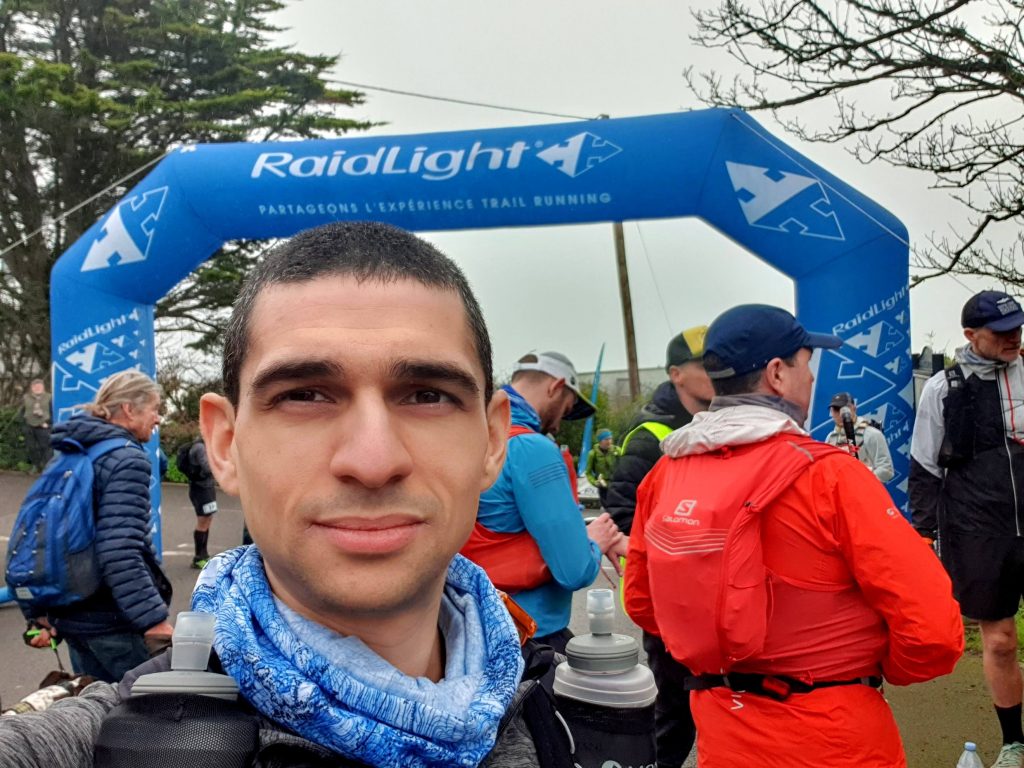
The start of the Arc is an impressive affair; the banging of the drum, and off into clouds of blue smoke. I nestled into around 30th position, roughly where I wanted to be to avoid getting caught in the throng for the early single track climbs, whilst avoiding holding the faster folk up myself. That didn’t really work, but not for the reasons I expected.
The fast pack took a wrong turning after just a few hundred metres into Coverack, and I found myself leading the race (I think) as we entered the trails. It stayed that way for a km or so, until the faster folk managed to forge paths back to the front, and as they did I pulled over to let them overtake one-by-one. As some big names passed me, I reflected that it was a surreal start to the race. Unfortunately, amidst all the excitement, I’d been pushing considerably harder than I ought; the old adage, don’t go out too fast, had not been heeded.
(Note: having listened to the Arctermath episode of the Trail & Error podcast, it sounds like Tristan may have been ahead at the start after all. If I’d have known that at the time, it might have calmed me down somewhat!)
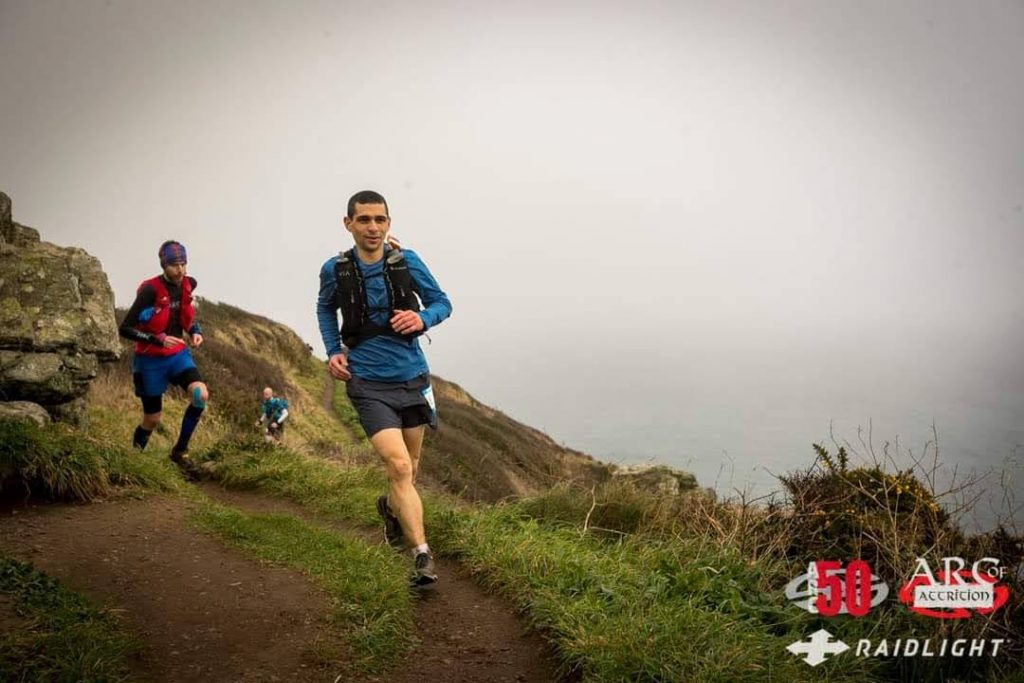
Based on a few things I’d heard, I was expecting the Coverack section to be a bit muddy to start, but otherwise fast trail to Lizard. As I was finding out, it was actually a hilly & technical stretch, just as much as the Lizard-Marazion segment I recalled from the Classic Quarter. It was not the easy start I’d been expecting, especially after my race-leading speed section.
We couldn’t see very far out to sea through the Cornish mizzle. I kept my midlayer on for little while, before removing it and simply running with my Patagonia baselayer. I was too hot with the mid, and too cold with the base. I chose the cold.
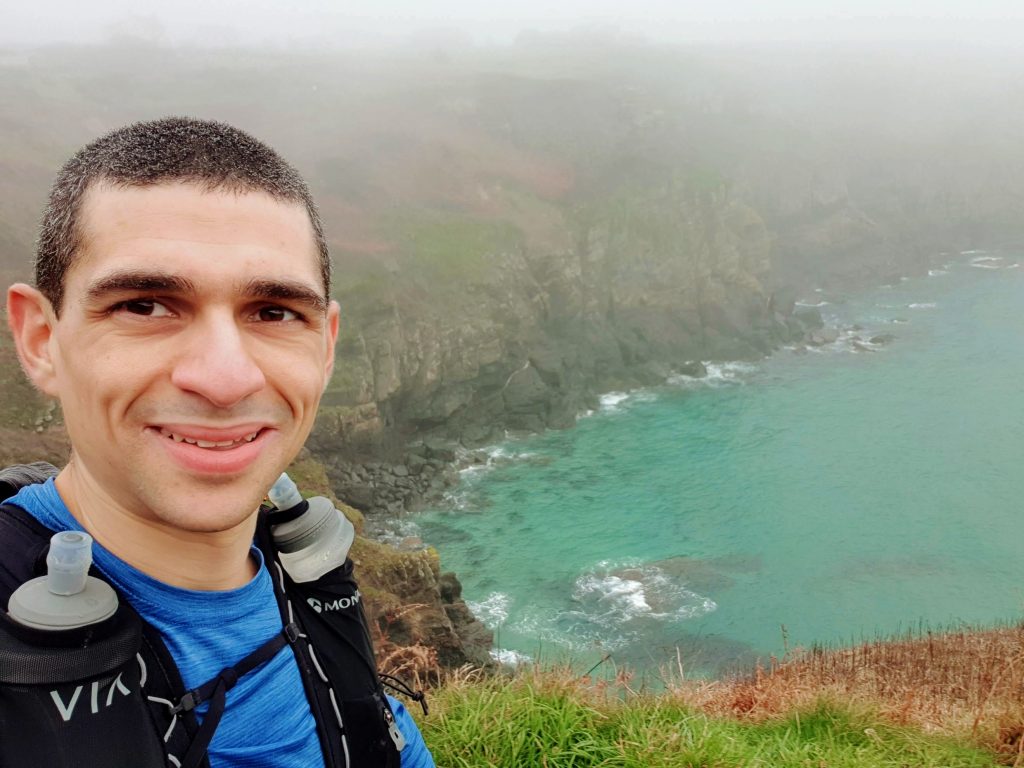
As we reached Lizard Point, I began to recognise sections of trail from the Classic Quarter, and quite enjoyed this little jaunt down memory lane. I reflected that I’d definitely recalled it with rose-tinted spectacles: this section is really technical, much more so than what I’d been training on over winter. I wouldn’t have minded, except I knew that relative to the Mousehole section, this was easy – so I was readying myself for a tough day and night ahead.
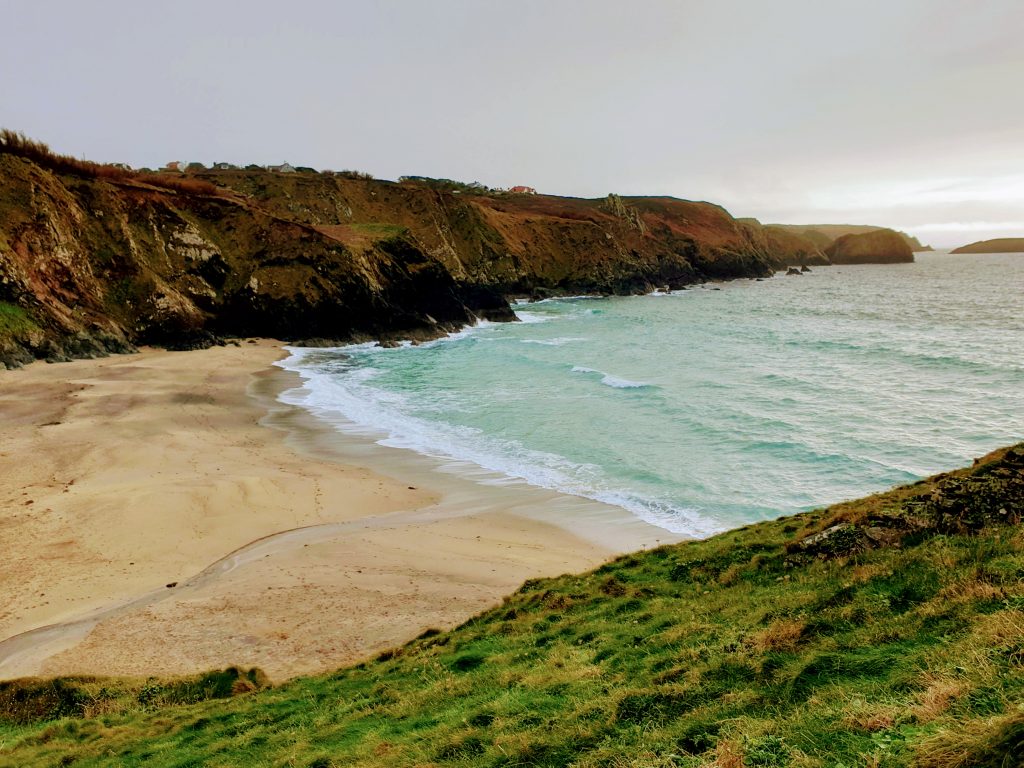
It’s a long winding route in and around all the various coves on the way up to Marazion. In toward land, along, out to the coast; down to the beach, over a stream, up to the cliff; and so on. After what seemed like an eternity, the mist cleared and the distant lights of Penzance came into view over the sea. It’s great to be able to see your goal, but getting there is quite another story!
The quads were, just like in the Classic Quarter, taking quite a hammering on the downs. I was wearing Inov-8 RocLites (I hadn’t managed to find a suitable X-Talon in my size beforehand), and the pair I was wearing for the first half had already seen more than 1500km: the lugs were pretty well worn. Their remaining traction wasn’t really up to the task posed by this slippery trail and its descents. This meant I was having to take more care than usual, and that involves braking – or, in other words, repeatedly jolting one’s entire bodyweight through the quads.
Carrying a 5kg pack was proving quite an experience too: whilst my Montane 12l was doing a brilliant job, there’s simply no way to ignore an extra 10% of your body weight on your back. At least it provided a tangible incentive to drink my water and consume my calories, in an effort to reduce pack weight.
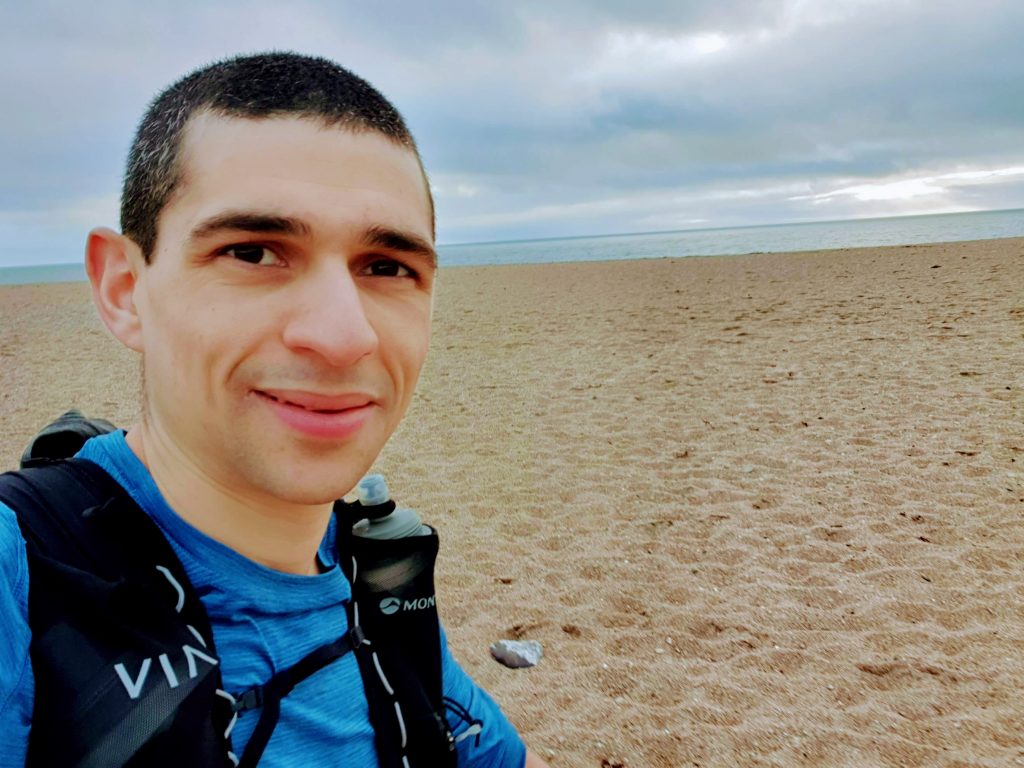
By the time I reached Loe Bar beach, the early exertions had taken their toll, and I was starting to flag. I walked pretty much the whole length of the sandy beach. On the other side, there was a climb up away from the beach, back onto coastal trail, where I got going again.
The sun was gradually setting as I approached Porthleven. The mizzle had cleared, and the wind was still subtle. So much for a winter ultra: this was glorious!
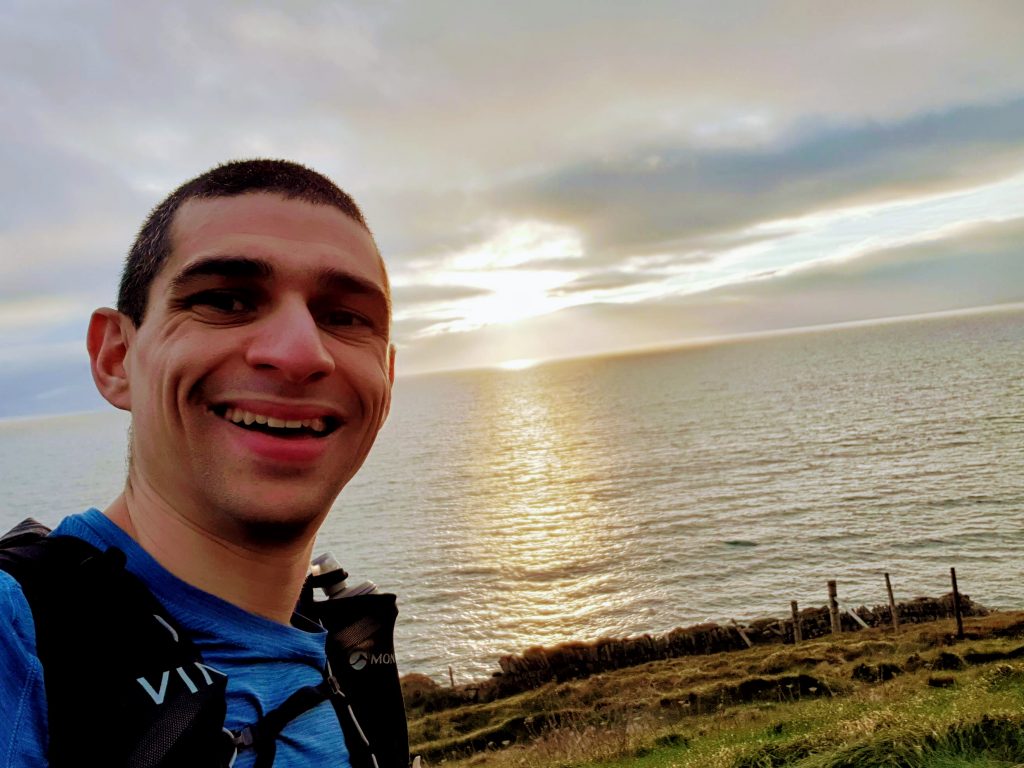
On arrival, I was amazed to find Arc “valets” waiting to run us up to the aid station. A 5-star service indeed. I got some potato and leek soup down, a bit of watermelon, and refilled my bottles. A 5-10 minute turnaround at most. The soup was rejuvenating, and I scooted out of there relatively happy. I’d forgotten to add a Tailwind sachet to one of my water bottles, so paused just beside the sports field, tore a corner off the sachet, and delicately tapped its contents into the bottle. Despite my efforts, half of it went over my hands, my pack and my shoes. I grinned: that would teach me to be better prepared at the next aid station.
I checked the time, and it was excellent – I was way ahead of schedule. Despite a fast start, a heavy pack, and slippery terrain in my overly-well-worn shoes, I was doing OK.
Passing through Perranuthnoe, I recalled some advice I’d received about a common routing error people make at Trenow Cove: stay right on the path, don’t veer left down onto the beach. Surely that was obvious, I pondered, as I absentmindedly forked left and cruised down a lane, headed toward that very beach. Fortunately, I spotted my glaring mistake within 30 seconds. I swung around, mildly embarrassed, and jogged back up the path, explaining my mistake to a confused runner who had followed my lead.

Light was fading, so I donned my Fenix HM65R-T and turned on its 400 lumen spotlight. I prefer the Fenix over the Nao+, which I was also carrying, in the capacity of a backup light.
It wasn’t far to go to Marazion. Whilst I didn’t recall much about that town from the Classic Quarter itself, I had subsequently walked there from my B&B in Penzance, along the beachfront promenade for a green tea in the Godolphin, before hotfooting it back in the pouring rain. A charming historical seaside town, I was looking forward to running its winding high street once more.
As I emerged from the coastal path onto a residential street, I remarked to waiting crews that it felt good to be back in civilisation, and felt my pace quicken with expectation. Marazion was exactly as I remembered it, and I reflected how pleasing it was to be back again so soon. I passed the Godolphin, and ran through the car park alongside the beach, before carving a path through the strip of sand leading to the brand new promenade running along the Marazion-Penzance beachfront. During May last year, it was still under construction, so we’d had to run along the roads instead; this time around, it was a far more pleasant experience. I was quite content plodding along here, ensuring I maintained a healthy pace to make the most of this rare stretch of flat.
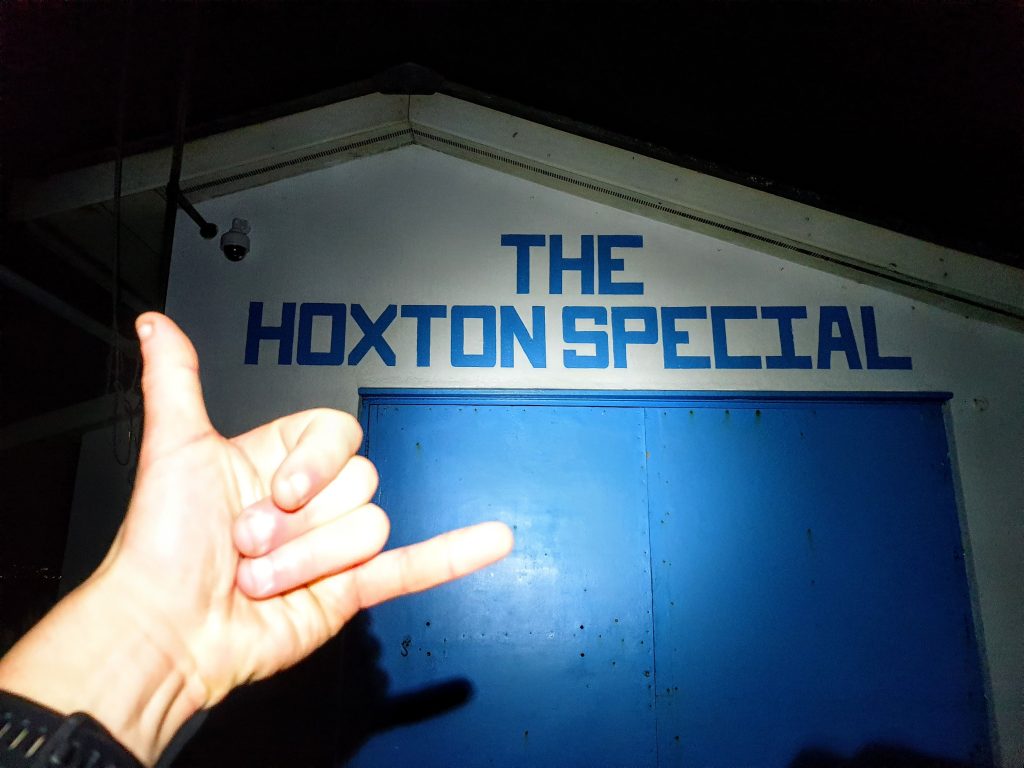
Approaching Penzance, I could see another headtorch up ahead, and quickened my pace to make up ground. My background is more road running than mountain, fell or trail, so I felt as though I should be coasting past people with ease here. I was surprised by their pace – this runner was going some. Not to be outdone, I sped up even more. Eventually, beside the train station, I drew alongside the runner, who – to my surprise – stopped running and stepped to one side, before offering me some words of encouragement. It was just a local, out for their evening run.
I was in good spirits as I threaded myself along the familiar streets of Penzance. The aid station was directly opposite the B&B I’d stayed in previously, so I knew my way; but the Mudcrew valets were there again, ready and waiting to run me from the promenade up to the rugby club. It was nice to have them to chat to after the stretches of solitude.
In the aid station, I downed some carrot & coriander soup, some chips (ultras certainly aren’t health drives), refilled my bottles, and headed straight back out into the night. Another fast turnaround under my belt.
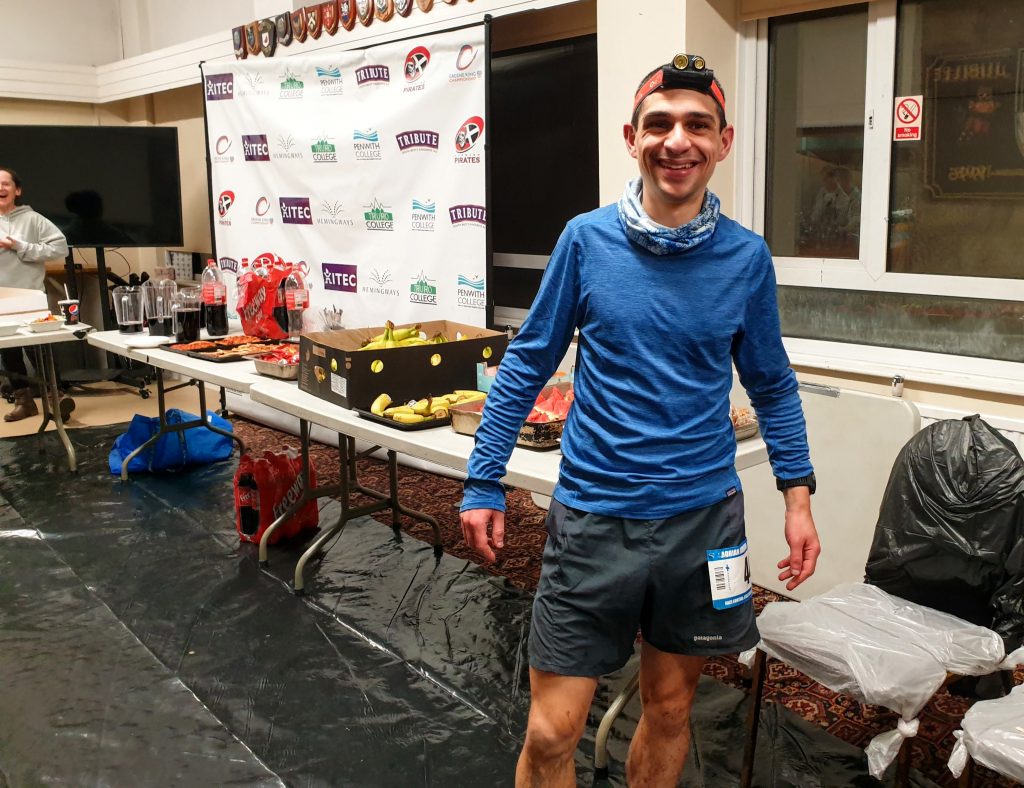
It’s easy running into Newlyn and through to Mousehole, where the coastal path fiddles around the town somewhat before heading steeply up back onto trail. My path crossed a runner who remarked I’d taken the scenic route, and asked me how much extra distance I’d added on. I hadn’t: the route I’d taken was the marked coastal path, and matched the GPX route.
As soon as I hit the trail and switchback, my thoughts switched to the extremely technical section I had to cover to reach Land’s End. In the Classic Quarter, I’d run this stretch during the daytime, and mostly remembered it as a ponderous, slippery technical trail consisting of lots of clambering, linked by short runnable sections measured in just tens of metres.
It was mostly as I recalled. There was some very mild exposure, which I found delightfully atmospheric at night: the vivid sounds of the waves crashing against the shoreline replaced the eyewatering visuals one gets during the day. Those runnable sections were quite special in places. Yet, the technical sections were just as unrelenting as I had recalled, and the downs were pretty treacherous (especially in my heavily worn Roclites). In places the muddy trail was replaced, without warning, by bogs that swallowed one’s entire lower leg. These made the regular stream crossings seem like something of a blessing in comparison.
On the start line of the race, I’d noted that most of the runners were wearing gaiters. It was during this stretch that I really wished I was too, as my shoes were hoovering up debris like a Dyson. I stopped once to remove a large jagged stone, but otherwise tried to ignore it all: I had a change of shoes waiting in my drop bag at Land’s End. So long as my feet survived this section, help was at hand.
Out of nowhere, a spectator emerged and informed me I was approaching Minack Theatre. This excited me: Minack had completely passed me by during the Classic Quarter, and having subsequently seen photos of the nearly 100-year-old open air theatre, I was keen to see it in person.
Of course, it was nighttime, and yet again I didn’t get to see any more than the car park; but this setback didn’t dampen my spirits, as Minack was a solid milestone along the route to Land’s End. Talking of milestones: for some reason, I thought the stretch from Penzance to Land’s End was some 40km, and thus expected to pass the 100km mark well before arriving into the third checkpoint. I was carrying a detailed race plan in my pocket, but the ongoing technicality of the terrain didn’t afford many opportunities to decipher tiny text, so I never checked it. In reality, it was only a 25km stretch, and would finish well before I hit 100km.
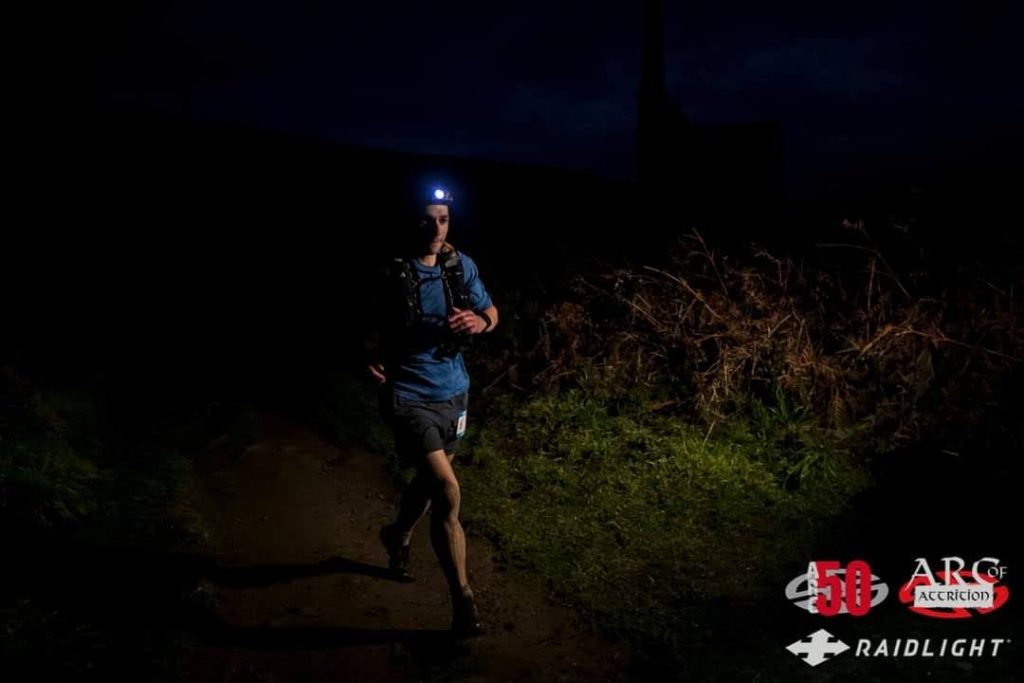
Whilst moving at this slower pace over technical terrain, the mizzle and building wind was proving to be a frustration. It was hard to work out what to wear – whatever you chose, it was a compromise. I also knew I had a different midlayer waiting at Land’s End. Considering my clothing options kept my mind occupied for a while, as I picked over the rocks.
I was tracking the compass on my watch, and became excited as it wrapped around to face north. Land’s End was inching closer. I knew the landscape in this final stretch opened right up, both providing some visual stimulation, and facilitating some longer, free-flowing runnable sections. Then I observed what looked almost like a rising sun flickering into view over the hills. It was the Land’s End Hotel, bedecked with a thousand warm yellow lights, shining like a beacon in the night.
As is often the case in ultras, seeing a target is quite different to reaching it. There was a lot of technical trail running between me and the aid station, on a trail that continually wrapped around the coves; each time, dropping rapidly down to sea level, then climbing straight back up. But that didn’t matter: my gait was flowing, I was feeling pretty good, and Land’s End was in view, where some veggie chilli was waiting.
For the third time, a valet met me some 500m out from the Hotel, ran me up the final ascent and into the aid station. Part of me wanted to run straight past, as I didn’t really want to interrupt my flow; however, there was business to attend to. I grabbed my drop bag and immediately put my watch and phone on charge. I had some 20 minutes or so planned here; time to change my shoes and socks, eat some hot food, and sort out my food supplies for the second half of the route.
Iwolfed down some of the bean chilli, and then a second helping. It was good. I also had some of the tomato soup, and a couple of slices of watermelon. I then turned my attention to my feet. My shoes were completely saturated with mud: not in clumps as I’d been used to dealing with over the winter, but properly, properly saturated with liquid goo. As I removed them, mud, stones, grit and sand flew everywhere. This revealed my brand new white socks, which were now unrecognisable. I peeled these off, which again spewed debris all over the hotel’s floor. I brushed off my feet as best I could, and donned a fresh pair of socks, and another pair of Roclites – fortunately, these had considerably better lugs than my previous pair. I then transferred labelled bags of nutrition to my pack (one bag per aid station, where I rotated it from the back to the front of my pack).
I had trialled a new food source during the first half of the race: a 250ml soft flask filled with c.125g of Tailwind and a little water, to form a sort of Tailwind gel. It hadn’t worked very well: first off, the water and Tailwind separated, requiring me to regularly massage the flask to mix the two. Secondly, it tasted quite sharp and very salty. I didn’t fancy that again for the second half of the race, so I left it behind in my drop bag.
My phone was sufficiently charged by now, but my Garmin 945 was still going. I wanted at least 80% charge, and resolved to wait. I hang around, drumming my fingers, with literally nothing more to do. I absentmindedly grabbed a packet of crisps for the salt, and wolfed them down, before reading the ingredients list to pass the time, and spotted a couple of things I don’t eat: milk and wheat. I hoped it wouldn’t upset my race. After a while, my Garmin showed 82% charge, so I pulled the plug & headed off back into the night. I’d not seen any of the route from here to the finish at Porthtowan, so what followed was guaranteed to be an adventure.
The trails leading out of Land’s End are well defined, but numerous and thus a little confusing. I was pretty cold, having been seated in the warm for a half hour or so, and so I tried to quickly get back to a good pace to warm up. However, this was proving challenging, as a problem was developing in my gut: I was feeling nauseous.
Ihadn’t ever experienced GI distress in a race before. I wasn’t sure what had caused it, and wasn’t too sure how to deal with it. I slowed down to let others pass, trying to maintain a clear path both ahead of and behind me, just in case I needed to upchuck. I stopped eating & drinking for a while, and briefly stopped off-path on a couple of occasions, hoping it would clear. I half-heartedly tried to force the matter a couple of times, without any success. After a while, I gradually started reintroducing food and water, and could sense a return to normality. I would be fine thereafter, and appreciated that nothing had come up: the last thing you want in a race, I reasoned, is to displace vast quantities of food and water, only to have to replace them again.
My temporary GI problem aside, I enjoyed the terrain from Land’s End to Pendeen Watch: it was less technical than much of the preceding trail, and afforded good nighttime views. There were glimpses of the lighthouse, and some fun sections clambering over boulders that reminded me of Snowdonia. I wasn’t tracking exactly where I was, or which crew stops I passed. It didn’t really matter. I was approaching the infamous Pendeen stretch, and I’d know it when I hit it.
I’d just dropped down a descent, the coast wasn’t far to my left, and the trail snaked gradually upwards and along the coastline. After a few strides, the trail was replaced by a pond, dotted with a handful of slippery rocks intended to be used as stepping stones. I successfully rock-hopped for a while, then my heart skipped a beat as my body plummeted straight through the muddy trail. I looked down, and couldn’t see my knees beneath the muddy bog I’d landed in. I reasoned that I had reached Pendeen.
Was the Pendeen-Zennor stretch as bad as people had claimed? I think so, yes. In a colder, wetter year, I can well imagine this stretch being borderline unbearable. It was bad enough as it was. The wind had really picked up by now, just as my pace had plummeted whilst trying to traverse this tricky terrain. My exposed legs were freezing. The mizzle continued.
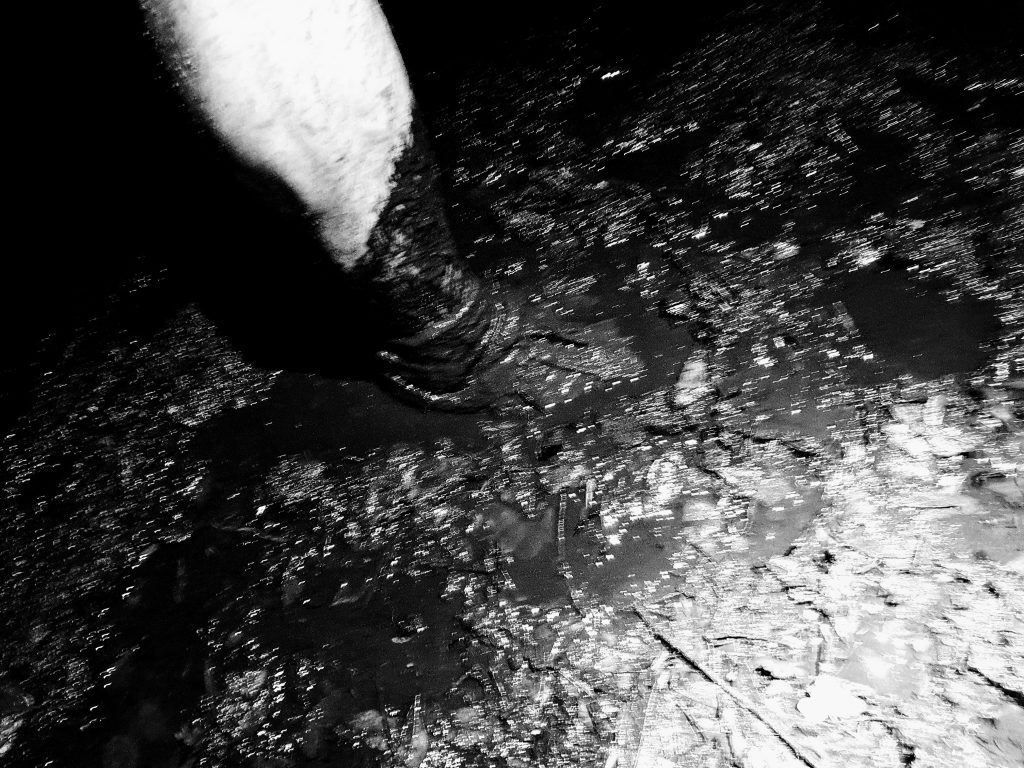
By the light of my headtorch, I slowly trawled through bogs & streams, tentatively picked my way down steep, slippery rocky paths, clambered over boulders, slid down mudslides, scratched past bushes of gorse, slipped over and shivered. I was moving so slowly, because I didn’t want to injure myself out here in the back of beyond. I wanted to finish the bloody race.
Before I’d started, I’d forgotten to disable my Garmin watch’s feature of beeping on every kilometre, and it had been mildly frustrating me ever since – beep, beep, beep. However, through this section, the beeps came so infrequently that I often wondered whether my watch battery had died. I was averaging 15 minute kilometres, slower than walking pace.
For me, the race was defined by this Pendeen – St Ives section, so the slow rate of progress didn’t overly concern me. I knew that with every step, I was breaking the back of this race. I counted down the kilometres remaining to Zennor Head, where I was hoping there’d be some Arc Angels waiting with water supplies. I hadn’t been drinking very much (the terrain was too technical to worry about that), but I intended to stop and down a litre at Zennor, and top up all of my bottles. So when I spotted a chap in a puffa jacket waiting at the top of a climb, I prepared myself to take on supplies. Something salty would be welcome, and I might even consider pulling on some trousers before I tackled the next half of this stretch.
When I reached the gathering of folks at Zennor Head, I immediately realised that my expectations were totally out-of-line with the reality. There was no shelter to stand under. There were no Arc Angels waiting with a van of supplies. As I scanned my eyes around the motley group of 5 cold, tired crew members, I realised how few supplies they had with them. I could see one part-emptied 2l bottle of water, and one more 0.5l bottle. A couple of handfuls of treats. There were obviously no cars nearby. This was it.
I didn’t want to impress my needs upon someone else’s crew, when they were clearly carrying only the bare minimum. If you’re crewing someone else, you don’t want to be put in the position of choosing between a random runner asking for help, and preserving supplies for the runner you’re crewing. So I didn’t even stop – I just ran straight on past, calling out a muted “hi” as I did so, and braving a smile. I immediately transitioned my mind to the next 10km of ugly, treacherous trail. It was time to batten down the hatches, puff out one’s cheeks, and push on to St Ives.
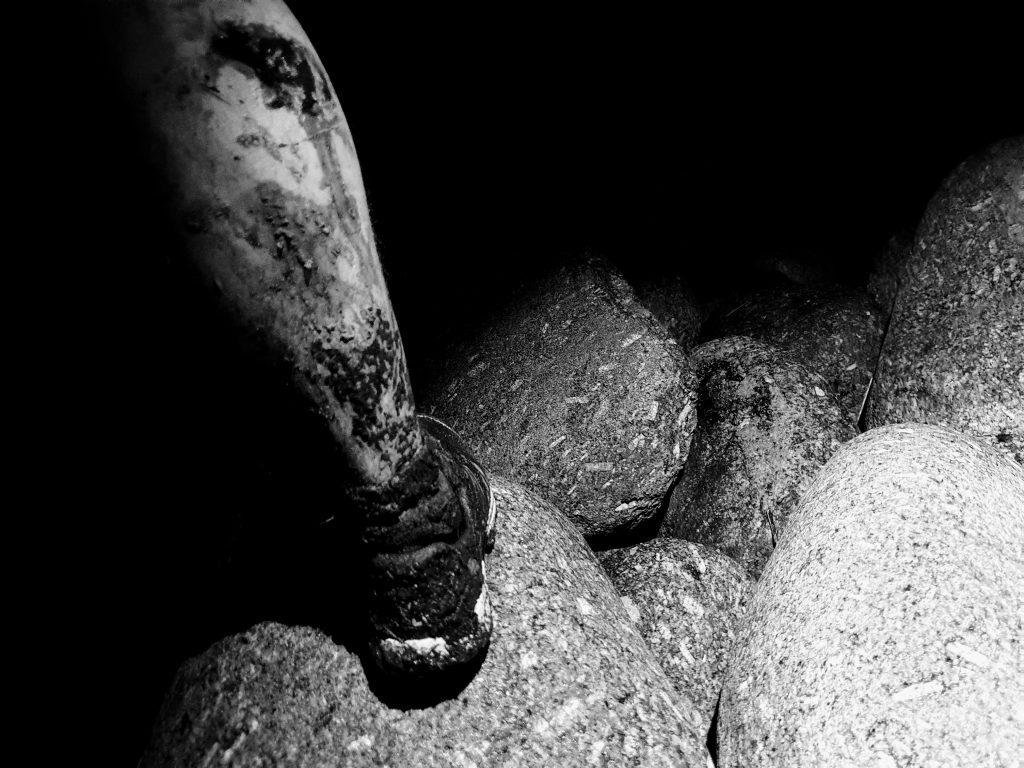
The Zennor-St Ives stretch was much the same as the Pendeen stretch. Probably slightly less boggy, with a few more runnable stretches, but still broadly as technical. As I neared the end of this interminable nightmare, darkness cleared and I could finally remove my headtorch. I was immediately relieved of a headache I hadn’t even realised I had. The terrain began to return to more traditional coastal path: the sharp descent down to sea level, over a bridge, around the cove, and sharply back up to the cliff.
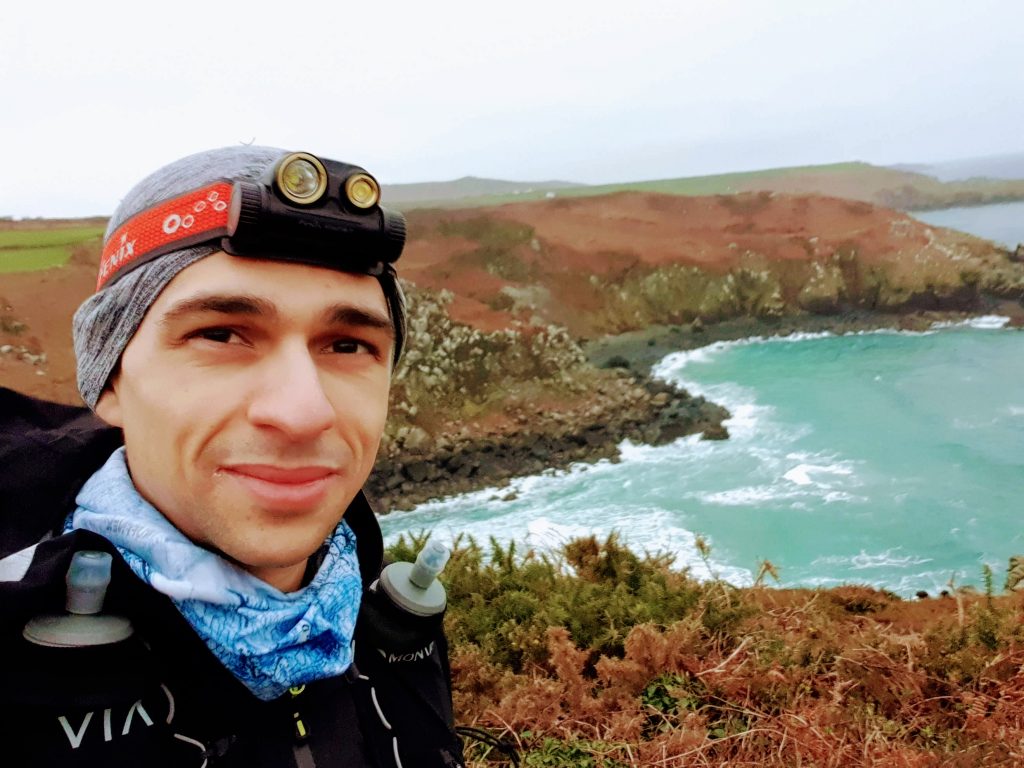
The shoreline was a thing of beauty: the sea’s vivid aquamarine colour lept out at me, in sharp contrast to the dark, dank, rugged coastal landmasses. After the nighttime ordeal, this was a holiday in the Maldives in comparison. And then the sight of St Ives beachfront emerged ahead of me: the houses on the clifftop, the neat row of perfectly painted beach huts (or houses; one couldn’t make out the details at this distance). Its cleanliness and neatness looked as far removed from the treacherous Pendeen rock-hopping bogland as I could imagine.
As I ran in the last kilometre or so, I knew I’d broken the back of the race. The hard part was over: now, all that remained, was an easy, flat road section straight into Porthtowan. The Arc was done.
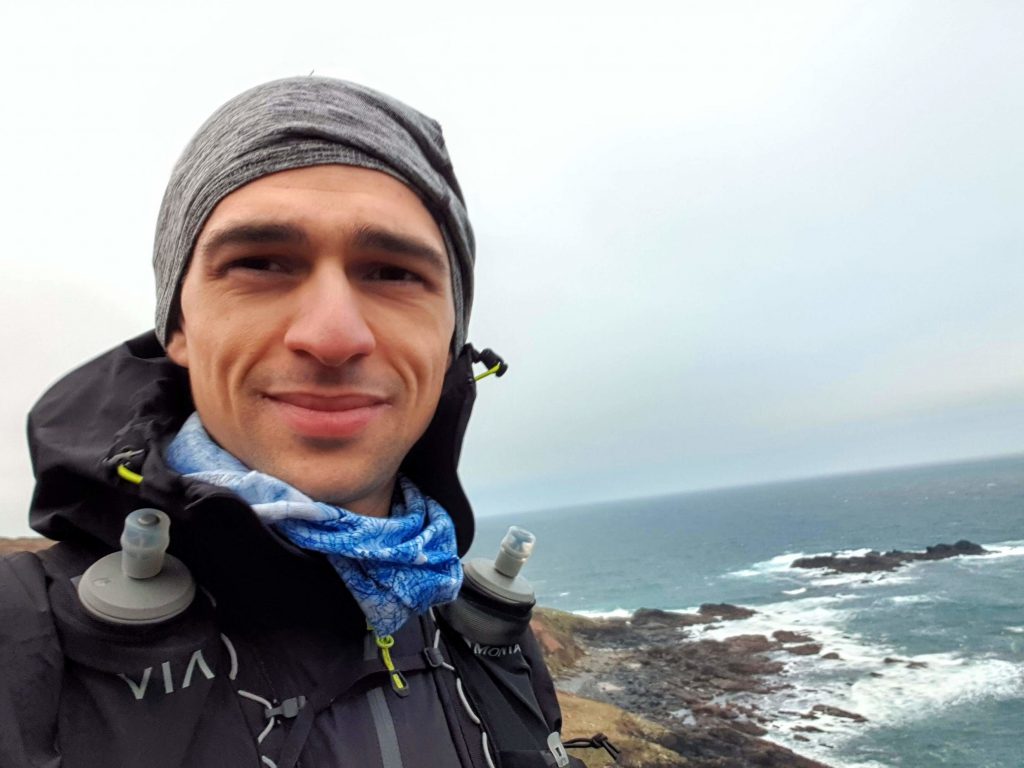
I bumped into Stephen Cousins on the approach to the beachfront, who invited me to stop for a minute to speak to the livestream. “That was horrible”, I exclaimed in a jocular fashion, pointing back toward the path to Pendeen.
I headed off at a good pace, along the promenade, following a few rare route markings, before the Arc valets picked me up and ran me into the final aid station. I wasn’t as talkative this time around: my brain was a little frazzled, and I was busy preparing my mental checklist of actions.
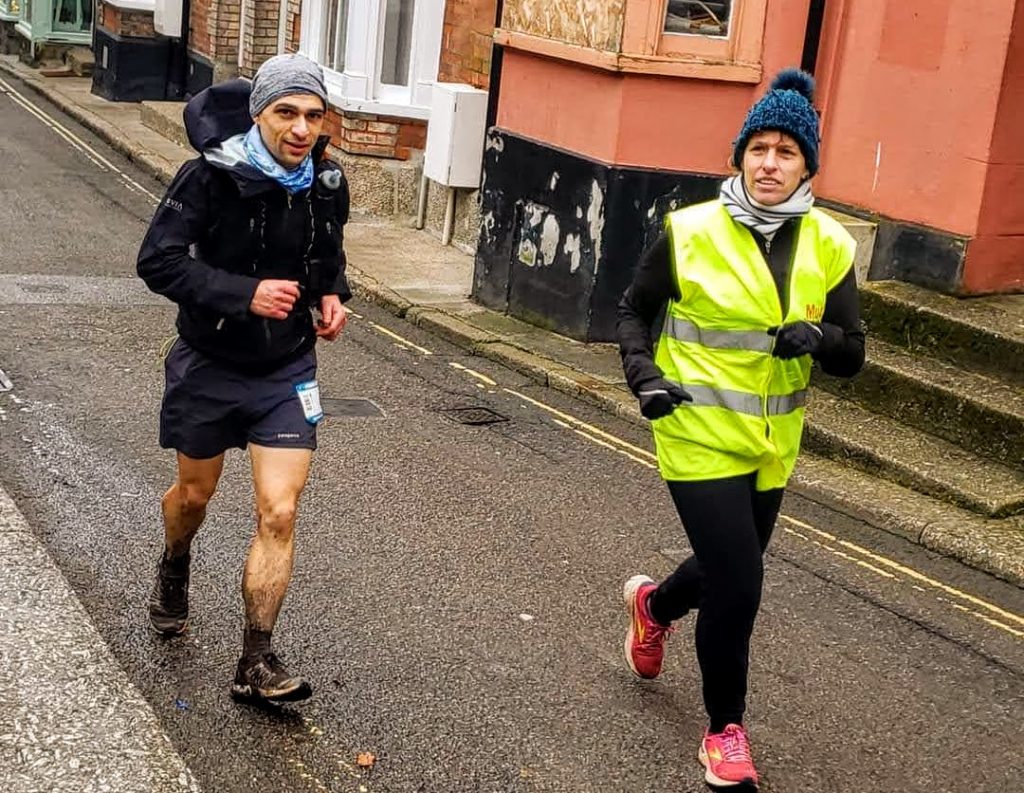
As I entered the aid station, I was greeted by a beaming volunteer, who took my order for chilli and soup, and congratulated me. “The cut-off isn’t until 2pm – you’re in great time!” she reassured me.
The cut-off, I thought? Hold on right there; why is anyone talking to me about cut-offs? Just how long had I taken to get to St Ives?!
I checked the remaining distance on my race plan, and did some quick mental calculations. I was behind schedule. Well behind, by at least an hour. I didn’t want to figure it out precisely, I just wanted to get the heck out of there. I wolfed down my food at lightning speed, removed a shoe to try to dust off some of the accumulated debris (which was so utterly hopeless I didn’t even bother trying with the other foot), moved some of the contents of my final bag of nutrition to the front of my pack (I hadn’t consumed much up to St Ives), and hotfooted it back out of the aid station. I really had to shift up a gear.
It began to sink in just how much running still remained. I may have broken the back of this race, but it was far from over. At least it was flat, easy road running from here on. I was fast on this sort of terrain, and I’d make up loads of time, I told myself.
Approaching Hayle, I thought to double-check the charge on my Garmin, and got a huge shock when I saw that only 14% remained. No, 13% – it had just ticked down whilst I was staring at it. I pulled over to the side of the road, took off my pack, pulled out my dry-bag and dug around for my portable battery pack. I couldn’t find it. Confused, I dug around my pack instead, but still couldn’t locate it. I checked my dry bag a second time. No, not there. I racked my brain: had I removed it at Land’s End? Possibly, I couldn’t remember. Had I accidentally put it back in my drop bag instead?
I sat there, contemplating this possibility, and swore loudly, just as a family I’d run past a couple of minutes ago strolled back past me. If I had no charger, that meant in a couple of hours I’d lose navigation. And my route recording, of course; but the bigger concern was the navigation. Without this, there was a real likelihood that I’d lose significant time to routing errors. Goodness knows when I’d finish – I wasn’t at risk of being timed out, but I was certainly at risk of taking a long time to finish. Was it possible that I might even take longer than 30 hours? Fucking Garmin and its shitty battery life!
I remained seated on the grass, looking out over this picturesque little village, taking a moment to control my thoughts and feelings. I accepted the outcome, whatever it was, and then emptied the contents of my pack onto the grass verge – I had to be sure. The last item to fall out was a transparent plastic bag, containing a coil of wires wrapped around a black battery pack. I was back in business.
I remained seated for a while, allowing my watch to charge, and just soaking up the atmosphere. It had turned into a most pleasant Saturday morning: the high wind gusts that had plagued us overnight had ceased, for now, and the sun had come out. It was lovely.
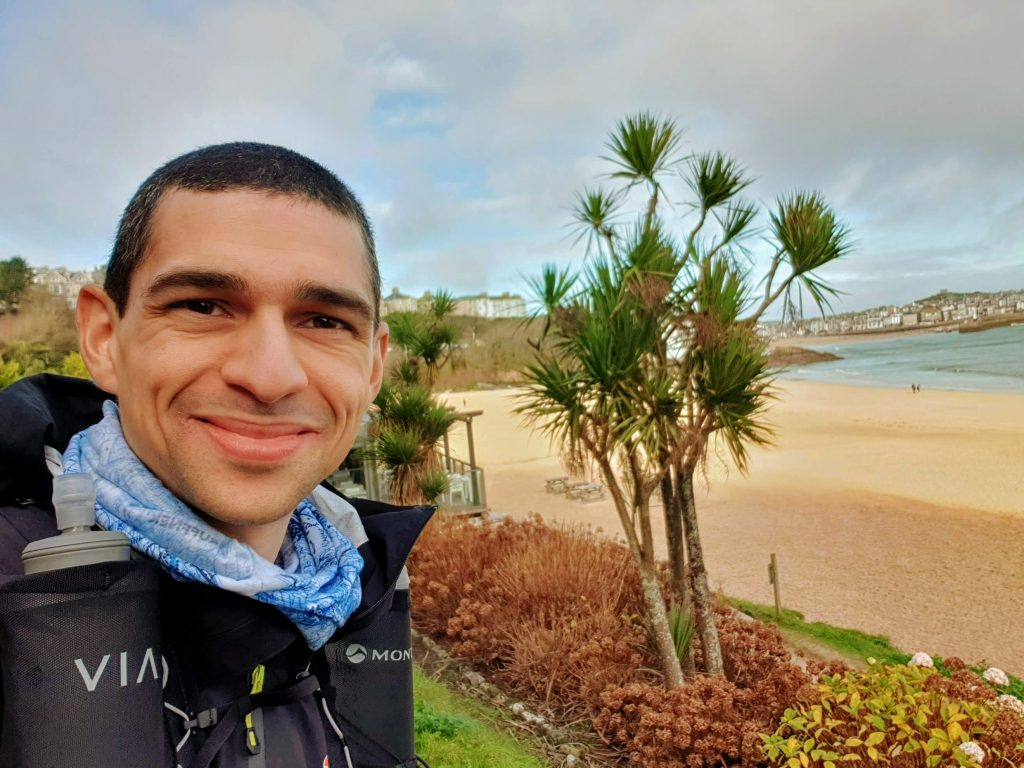
I re-packed my pack, stood up, and began walking, holding my charging watch delicately in my hand. Another competitor jogged past me, and we got talking about something-or-other, and matched pace. We ran together for a while through Hayle, discussing watches, ultras we’d run; all the usual stuff that runners do. After a short while, despite his outward demeanour, I could tell he was struggling to keep pace; so, when he engaged in discussion with locals on the outskirts of town, I knew that was his way of peeling off, and my cue to push on and start racking up the miles.
It was at this point that I realised the roads had ended, and I was back on the coastal path. I thought back to how I’d garnered the impression that the St Ives-Porthtowan section was all flat road. I couldn’t remember where that’d come from, but it clearly wasn’t accurate.
This was around about when I hit the dunes. The “Dunes of Doom”: I’d completely forgotten about them. Someone had reassured me they weren’t as bad as they were sometimes made out to be, so I plodded over them with an optimistic outlook, while sand blasted into my face by the winds that had clearly returned from their lunch break. Exiting that section, I thought the dunes were over: no trouble at all, I reflected, and hoped for a return to road. That wasn’t to be.
The real Dunes of Doom loomed ahead, and consisted of some kilometres of rather significant hills of sand, dotted periodically with slate waymarkers, which aren’t always the simplest to find. Whilst the GPX route keeps you roughly on track, it’s not accurate enough to tell you precisely which dunes you need to summit and which you need to skirt, so it’s a bit of a route finding exercise for the uninitiated. Meanwhile, the wind really had picked up again. The hood of my Montane waterproof jacket was thrashing against my face with a vengeance.
Once through the dunes, it was a return to the usual trails. These, though, featured a little more gorse, which was scratching my legs something rotten. On more than one occasion, I grabbed onto gorse for some support while descending, the marks from which are still visible on my hands. Otherwise, this was a fairly fast trail stretch, more runnable than much of what had preceded it.
I used the mental break to try to calculate my expected finishing time. This is an activity that most runners struggle with near the end of an ultra, when the simplest of math can become fiendishly difficult. As it stood, I reckoned I was on for about 28-29 hours; but, of course, this depended on the terrain that still lay ahead. What if there were more surprises to come? It sunk in that, in the worst case, I could be pushing the 30 hour mark, after which the reward transitions from a gold to a silver buckle. I had absolutely no intention of exceeding 30 hours. Nor did I want 29-hours-something. I didn’t think I could run sub-28 at this stage, so I was absolutely determined to run a 28-hour-something time, no matter what.
In a mild panic, I picked up the pace. Each runner I saw, I set my sights on, pushed on and overtook, and then set my sights on the next. And so it went, again and again, until we hit the big hills. There were a series of 4 or so sharp descents and ascents up steep steps. I probably lost a little time on the descents, but hammered the ascents as best I could: I simply had to make 28-hours-something. I reckoned it might be 28:45 the way I was going, so it was going to be tight – and I still didn’t know what remained.
I hammered down the descent into Portreath, overtaking a few runners before passing the Portreath crew stop. Someone left the crew stop just after me, so there were a good few on my tail. The route in the town then switched back, and I was presented with a road ascent to the right, and a footpath descent to my left. I picked the road, then stopped a little way up. I wasn’t sure. I headed back down, and took the footpath instead. Halfway down, I still wasn’t sure, and headed back up. I stood beside the fork, scratching my head, as a couple of runners approached me, and I motioned to ask the way. The road to the right, they signed. Off I went, at pace, to make up for my indecision.
The road snaked around, and continued to ascend. I spotted a man and woman running together ahead of me – after my exertions over the hills, they looked in better shape than I felt. I resigned to sit on their tail for a while, but nonetheless I found myself gradually making ground on them, and as we veered off the road back onto trail, I passed them. The woman (the 3rd lady I believe) commented that my gait was looking good, and I returned that they’d soon overtake me again in a minute. It was all very friendly; however, at this stage, I had no intention of ceding places.
The trail took me past a couple more abandoned mineshafts, and dropped down into Porthtowan. This was it. I could see three runners ahead of me: Danny Fox, Steve Adams, and Duncan Oakes. I cranked into another gear. I was peripherally aware of the supporters cheering and bell-ringing along the route through Porthtowan, but I was focussed and pushing hard now – I wanted to take all three places. I was very aware of the importance of overtaking them at significant pace, so as to discourage them from trying to follow me. So I was flying when I overtook the first two on the descent, and felt confident they wouldn’t feel it worth trying to catch me – but that left one runner still ahead of me, and he was motoring, no doubt sensing the finishing line.
My first instinct was that I wouldn’t be able to catch him; and if I did, it would take so much effort that I wouldn’t be able to hold the place. But then we hit a gradual ascent, and I found myself making up ground again. This was it – I found another gear and flicked into an all-out sprint. I shot past him, cornering left and then right onto the road I’d driven from my lodgings in Mount Hawke to the race start at the Eco Park. There were volunteers along the route, who I think were commenting on my pace; but I only had tunnel vision for the yellow arrow 200 metres along the road, pointing up the final hill climb to the Eco Park. I was really motoring.
Up and over the verge mound, onto the trail, and up. It was one steep climb up the circa 60m hill; a switchback path snaking past gorse and yellow flowers. I thought I could hear the sound of twigs snapping from my competitors hot on my heels, but I didn’t look behind: I didn’t want to give even the faintest sign of weakness. I powered up that hill like my life depended on it, straight past Stephen Cousins at the top congratulating me on the gold buckle, sprinted across the grass, past the Eco Park’s cafe, and raised my arms as I passed underneath the bright blue Raidlight arch marking the finish of the race.
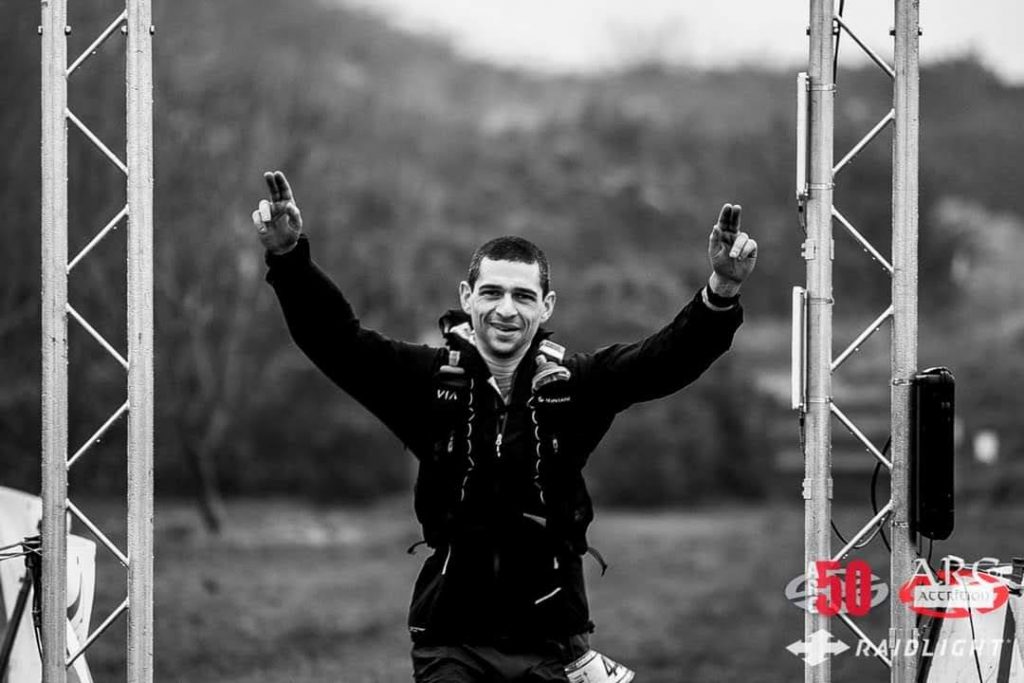
The photographer, caught off-guard, jumped to his feet and started snapping photos. I finally looked behind me, expecting to see one of my competitors decelerating over the finish line, shaking his head from having just been pipped at the post. But there was nobody there.
I accepted my buckle, and had my photo taken in front of the Arc’s finishers board.

Duncan Oakes finished 4 minutes 17 seconds later. I could have walked that last stretch. I could have walked that last hill. Heck, I could probably have walked from Porthtowan.
I finished in 28 hours, 12 minutes, 31 seconds, in 31st place.
The Arc is a challenging sod. A lot of it is run overnight, during winter, fully exposed to the Atlantic winds. The stretch to Marazion is technical and rugged. The stretch to Land’s End is even more technical, with only short runnable sections. The stretch to Pendeen is still fairly technical, until you get to Pendeen, when it’s a case of sticking with “the path” as best you can until St Ives. It’s almost impossible to avoid slipping and falling on this section, so it’s more a case of ensuring any falls you do have are sufficiently mitigated to avoid serious injury. And whilst arrival into St Ives logically feels like it must be the end of the race, there’s another 35km of coastal trail to go, including several km of significant sand dunes, and finishing with a series of big hills. And all that with only 4 aid stations and 1 drop bag, for those amongst us who run uncrewed.
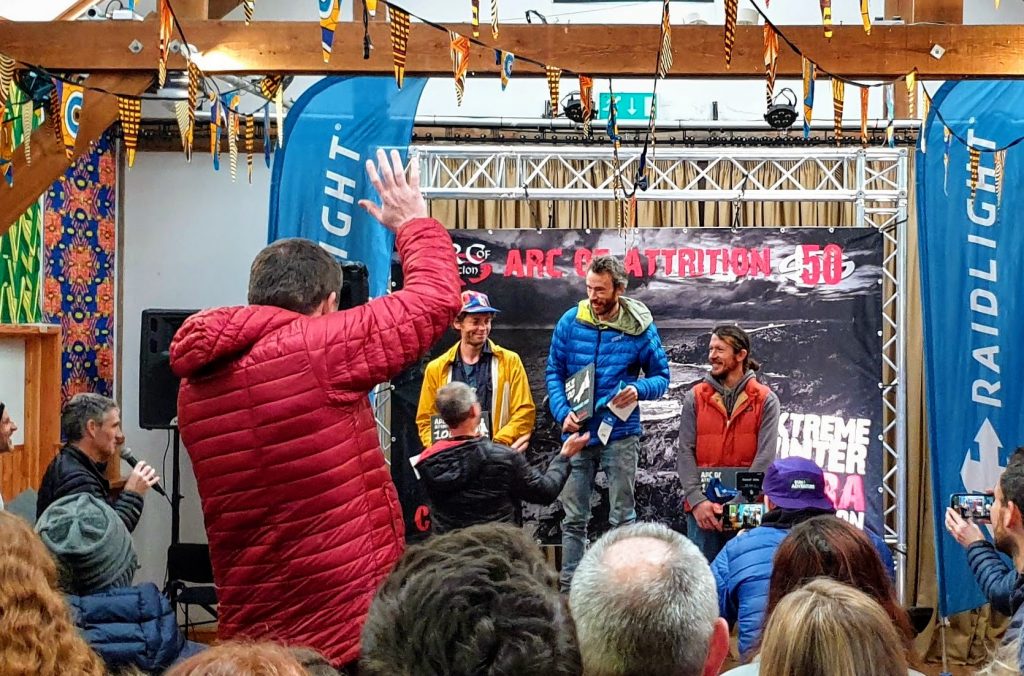
What it does have, though, is some seriously impressive organisation, comprising over 200 beaming volunteers & Arc Angels, working their socks off to support you around the course. If you’re going to put on a winter 100 miler around this tough, rugged, remote course, then the Arc is exactly how to do it.

